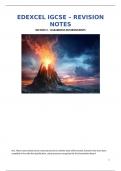Interview
Edexcel IGCSE Geography - Hazardous Environments [Detailed and Accurate]
- Course
- Institution
The Edexcel IGCSE Geography notes were compiled in line with the specification, consulting textbooks, websites, and studies. These notes take the form of notes, diagrams and summaries. These notes were used by numerous students, all of whom achieved Grade 8s and 9s at GCSE for Geography. The n...
[Show more]



